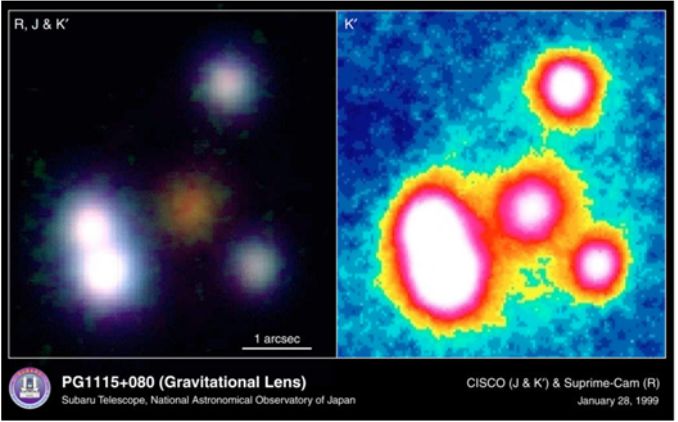
home •
about •
essential guide •
picture of the day •
thunderblogs •
news •
multimedia •
predictions •
products •
get involved •
contact
picture of the day archive subject index
Credit: CISCO, Subaru 8.3-m Telescope, NAOJ
Jul 27, 2006
Gravitational Lensing or Birth of a Theory?As doubts undermine the theory of gravitational lensing, curious minds begin making new theories.
A previous Picture of the Day noticed that curious minds were wondering what else the five bright spots could be besides gravitational lensing of a background quasar by a foreground galaxy. Currently accepted theories were failing to account for an increasing number of observations and skeptical questions. The bias of self-interest was beginning to show, but the habit of scientific methods was undermining the bias.
With this image the Subaru telescope looked at the five bright spots with its infrared eyes. It saw four bright quasars with bridges of luminous material connecting them to the galaxy. Halton Arp has collected hundreds of such images—usually pairs of quasars, sometimes three or four, often farther from the galaxy, but on opposite sides, as if the quasars had been ejected from the galaxy like roman candles. When the quasars’ z is adjusted to the reference frame of the galaxy and averaged for ejection velocities—one toward us, one away—the z’s fall on the empirically established quantization periodicities.
Curious minds now consider making (“poiein”) a new theory.
Arp considers that the mass of newly ejected matter is near zero and steps up per the quantization intervals as it ages. Z is therefore a measure of time since ejection, quasars are the “children” of active galaxies, and everything we see in the universe is a lot closer than what the Big Bang imagines.
Peratt, following Alfven, considers that galaxies and quasars form in “pinches” in intergalactic Birkeland currents. They evolve through the same sequence of forms as laboratory plasma discharges are observed to do.
Thornhill considers that intergalactic circuits power the fissioning of quasars from galactic cores and induce “leakage” currents that power the stars. These leakage circuits in turn power fissioning of gas-giant planets from stellar cores and induce leakage currents that power planetary systems.
And there are more—a bouquet of more—enough to satisfy curious minds who want possibilities, not dogma; opportunities, not obsolete certainties.
Contributed by Don Scott
___________________________________________________________________________Please visit our Forum
The Electric Sky and The Electric Universe available now!

|
|

|
EXECUTIVE EDITORS:
David Talbott, Wallace Thornhill
MANAGING EDITORS:
Steve Smith, Mel Acheson
CONTRIBUTING EDITORS: Dwardu Cardona, Ev Cochrane,
C.J. Ransom, Don Scott, Rens van der Sluijs, Ian Tresman
WEBMASTER: Brian Talbott
Copyright 2006: thunderbolts.info
![]()
home •
thunderblogs •
forum •
picture of the day •
resources •
team •
updates •
contact us

